NEWS
California Wildfire Update: Abhiyagiri Monastics Return Home After Sheltering at the City of Ten Thousand Buddhas
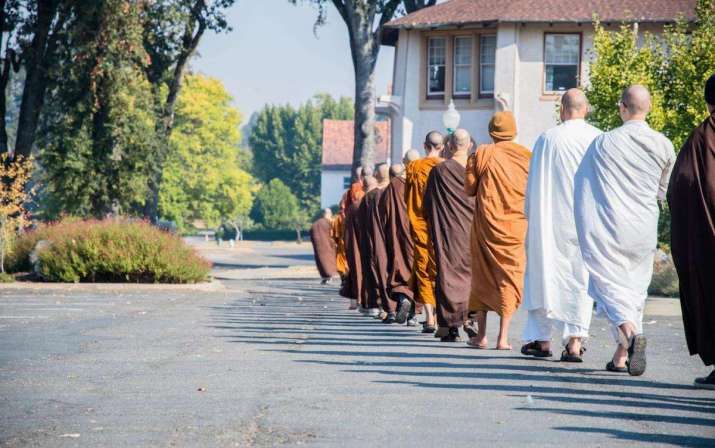 Abhayagiri and CTTB monks walk to lunch together. From drbu.org
Abhayagiri and CTTB monks walk to lunch together. From drbu.orgSEATTLE—In the wake of last month’s devastating wildfires in Northern California, which killed at least 40 people and left countless structures destroyed, the evacuated monastic community of Abhiyagiri Monastery were welcomed at the nearby City of Ten Thousand Buddhas (CTTB), 26 kilometers south of Abhiyagiri near the city of Ukiah. This brought the Theravada community, in the tradition of Ajahn Chah, into shared community and practice with the large Chan sangha at the CTTB, which was founded by the Chinese monk Xuanhua in the mid-1970s.
Jin Chuan Shr, writing for the newsletter of Dharma Realm Buddhist University (DRBU), housed at the CTTB, stated: “The spirit of having the Abhayagiri community at the CTTB was like a family reunion. Master Hua had established a Dharma friendship between the Thai Forest Tradition and DRBU and had especially praised their strict adherence to the Vinaya. Over the years, this friendship has grown through shared ordinations, ceremonies, and teachings. Yet this was the first time the two communities lived so closely together.” (DRBU News)
He continued: “At CTTB, the Abhayagiri monks were respected and supported in their Vinaya and training. In addition to maintaining their own practices, they joined fully in the life at CTTB: attending daily ceremonies, sharing the noon meal, and giving Dharma talks at IGDVS [Instilling Goodness/Developing Virtue Schools, a K-12 educational program] and DRBU. (DRBU News)
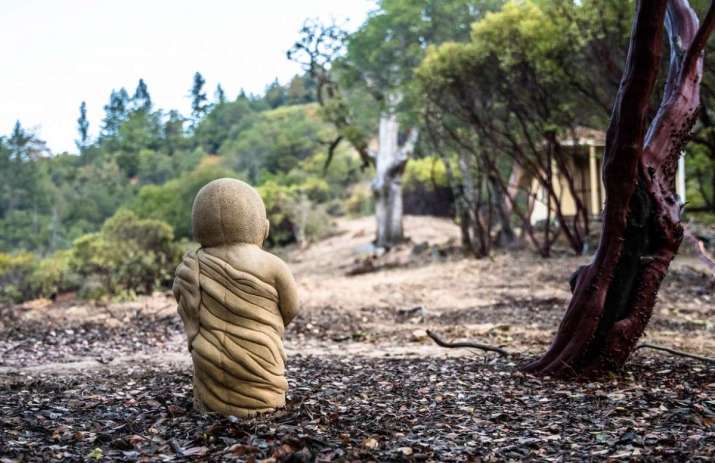 Black rock Buddharupa overlooking the massive fire break dug through the land. From abhiyagiri.org
Black rock Buddharupa overlooking the massive fire break dug through the land. From abhiyagiri.org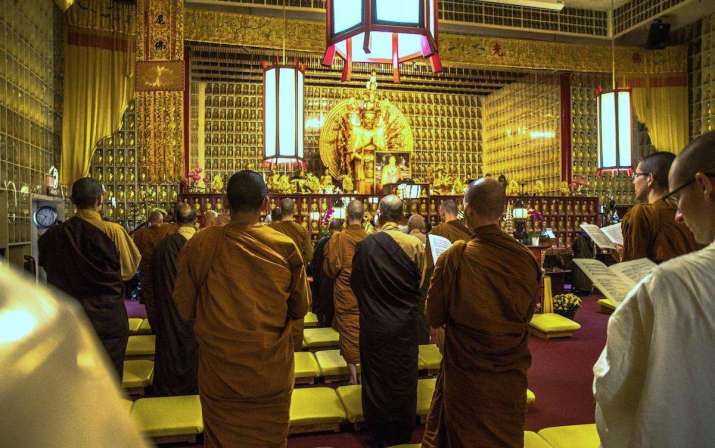 Abhayagiri monks, novices, and anagarikas at meal offering. From drbu.org
Abhayagiri monks, novices, and anagarikas at meal offering. From drbu.orgDuring their stay, 10 or more of the Theravada monks attended morning ceremonies, meal offerings, and evening ceremonies nearly every day. Luang Por Pasanno, the most senior Western disciple of the late Ajahn Chah and abbot of Abhiyagiri Monastery, arrived at the CTTB shortly after others, flying in from the East Coast where he had been staying.
“Curious about the daily CTTB practices, the Abhayagiri monastics asked many questions: Does everyone make Bodhisattva vows? How to bow properly from standing? Why do the CTTB monks rinse out their bowls after lunch and pour it on the ground?” (DRBU News)
In Dharma talks given by Abhayagiri monastics, Jin Chuan Shr related, “There was the constant theme of taking every moment as an opportunity to practice. Everything is impermanent. The state of Abhayagiri is “not for sure.” It is the nature of fire to burn; having a monastery in a forest means there is always a possibility of a forest fire. There is no use getting angry at the trees or the fire. If the monastery did not burn this time, it would burn at some future time. That’s just the way things are: impermanent.” (DRBU News)
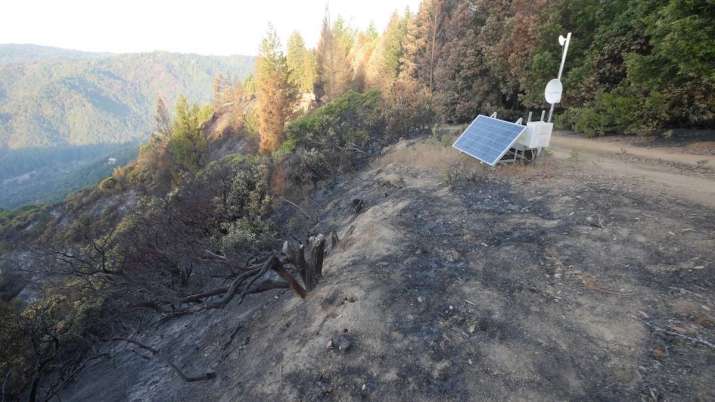 Somehow, the monastery sustained no structural damage. From abhiyagiri.org
Somehow, the monastery sustained no structural damage. From abhiyagiri.org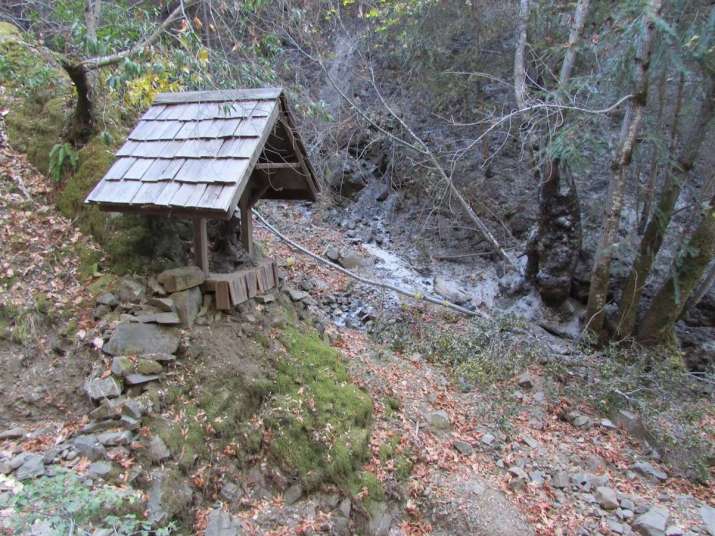 The Ajahn Chah shrine had fire on both sides, but did not burn. From abhiyagiri.org
The Ajahn Chah shrine had fire on both sides, but did not burn. From abhiyagiri.orgOn 17 October, after a week at CTTB, the Abhiyagiri community returned home to their monastery. Documenting their review, a caption on a photo at their website states, “Somehow we sustained no structural damage. The fire seemed to avoid all our structures!” (Abhiyagiri)
A survey showed charred areas around most of the monastery, many leading right up to trails, shrines, and outbuildings. However, the fire lines and the fortunes of wind and terrain kept the fire away from buildings. “There are likely many reasons for this blessing, with most of the credit going to the excellent work done by the multiple fire-fighting crews from many different areas, the post on the Abhiyagiri website stated. “We also believe there must have been some very powerful protective forces on the property looking after the monastery as we had fires coming from several directions that seemed to unexpectedly reverse direction.” (Abhiyagiri)
“On a more mundane level, we feel that the fire protection measures that we took prior to the fire (defensible clearances around buildings, trail maintenance, fire breaks, emergency procedures, etc.) were also very helpful. One thing we learned from this fire is that even with the extensive measures we have taken, we need to do more.” (Abhiyagiri)
The monastics have created a fund to help sponsor further fire-protection measures at the monastery.
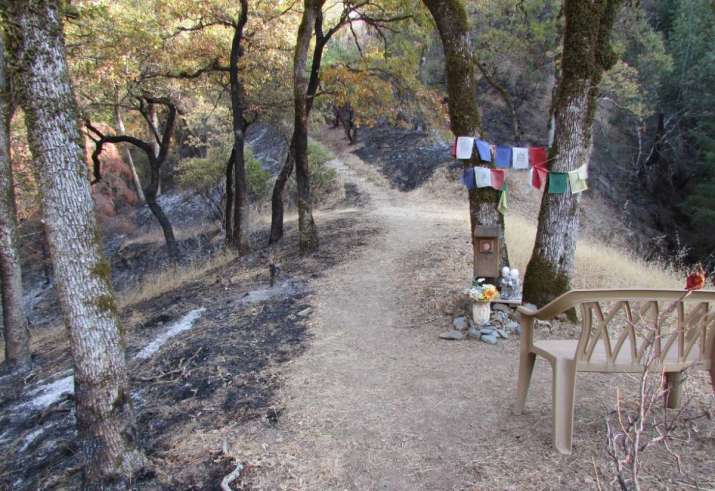 Thank you to the firefighters who prevented Steven Cope's shrine from burning. From abhiyagiri.org
Thank you to the firefighters who prevented Steven Cope's shrine from burning. From abhiyagiri.org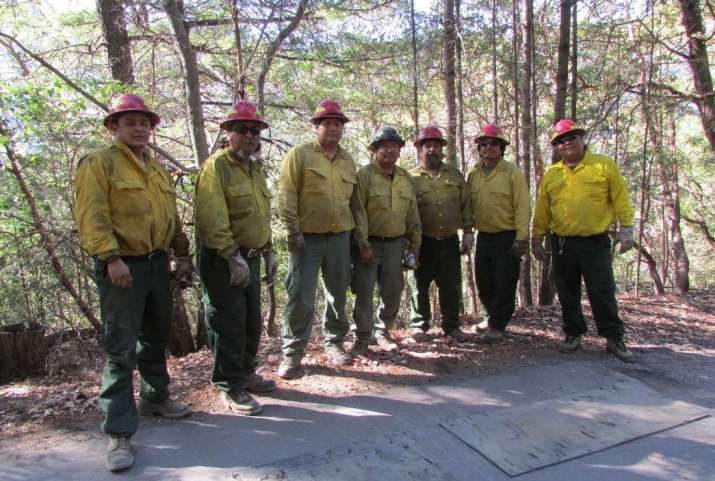 The fire crew from San Carlos, Arizona. From abhiyagiri.org
The fire crew from San Carlos, Arizona. From abhiyagiri.orgWhile the Abhiyagiri monastics took refuge at CTTB, the Soto Zen community of Sonoma Mountain Zen Center managed to stay put and fight the fire as it approached their property. On 11 October, they were told that several buildings on the edge of the property, including a memorial to Suzuki Roshi, were going to be lost in flames too powerful for the fire crews to fight off. However, when they were able to inspect the area, they discovered that the fire had come just to the edge of those buildings but had stopped there.
For the next week, they fought alongside fire crews and neighbors as new fires threatened the Zen center and surrounding community. However, the struggle ended on 19 October, when an inch of rain fell, allowing all residents to return. Writing for the Zen Center, Susan Gesshin Frey states, “We immediately held a small ceremony at Suzuki Roshi’s stupa consisting of burning incense and bowing nine times. Suzuki Roshi taught us that although normally students bow three times, we should bow nine times in gratitude for having Buddha appear.
“Although now Mountains are Mountains again, property lines returned, there is a subtle difference. We know what is possible. We are ever grateful to the ‘one mountain’ that included huge numbers of responders from all over the country, and especially to the ‘cat skinner Bodhisattva’ who bulldozed the firebreak across the steep land. We will maintain these roads and fire breaks knowing how precious they are. And we know that a small group of like-minded people working together with great spirit can have a large effect. (Sonoma Mountain Zen Center)
See more
Abhiyagiri Finds a Home at CTTB (Dharma Realm Buddhist University News)
Exploring the Monastery After the Fire (photos) (Abhiyagiri Monastery)
Fund for Fire Prevention and Trail Maintenance (Abhiyagiri Monastery)
Sweeping the Fire: California Wildfire Updates (Sonoma Mountain Zen Center)
Related news from Buddhistdoor Global
7th TLKY Canada Foundation Conference Held at University of British Columbia on 4 November
Researchers Seek to Unravel Mysteries of “Messy Manuscripts” from Dunhuang Cave
The Smithsonian Offers an Innovative Encounter with Buddhism
California Wildfires Drive Buddhists from their Monasteries














